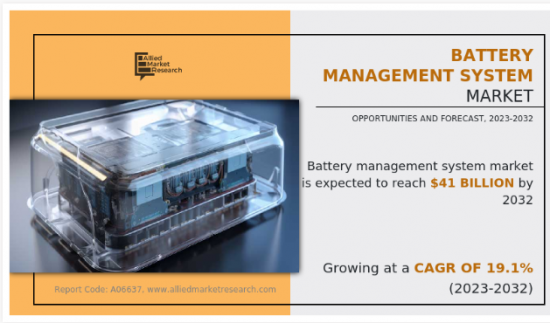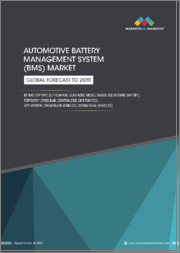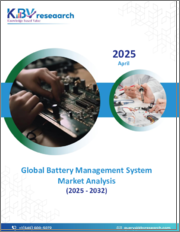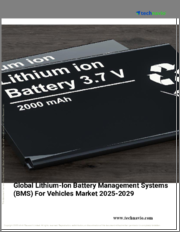
|
시장보고서
상품코드
1414773
세계 배터리 관리 시스템 시장 : 배터리 유형별, 토폴로지별, 용도별 - 기회 분석과 산업 예측(2023년-2032년)Battery Management System Market By Battery Type, By Topology, By Application : Global Opportunity Analysis and Industry Forecast, 2023-2032 |
||||||
배터리 관리 시스템 시장은 광범위한 최종 이용 산업에서 이차 전지의 사용 증가로 2023년부터 2032년에 걸쳐 19.1%의 대폭적인 성장률이 전망되고 있습니다.

예를 들어, 2023년 4월, 벵갈루루에 본사를 둔 첨단 전지 기술과 딥 테크놀로지의 신흥 기업인 Log9 Materials사는 인도 최초의 상업용 리튬 이온(Li-ion) 전지 제조 공장을 설립했습니다. 또한 회사는 리튬 이온 배터리를 관리하는 고급 전력 제어 알고리즘을 갖춘 배터리 관리 시스템 Charvik을 발표했습니다. 게다가 2023년 1월 전기차 충전기와 리튬 이온 배터리 제조업체인 엑지콤은 영웅 일렉트릭과 리튬 배터리용 배터리 관리 시스템을 제공하는 계약을 체결했습니다. 영웅 일렉트릭은 이 계약에 따라 매년 5,000대의 엑지콤 BMS(배터리 관리 시스템)를 구매하기로 합의했습니다. 또한 리튬 배터리 제조업체도 자체 배터리에 BMS를 제공합니다.
예를 들어, 2020년 12월, 리튬 이온 배터리 사업을 전개하는 Inverted energy사는 이 회사 최초의 선진적 배터리 관리 시스템 OJAS BMS의 발매를 발표했습니다. 이러한 신흥국 시장의 개척은 이 부문의 배터리 관리 시스템 시장의 성장을 가속할 것으로 예상됩니다. 분산형 토폴로지는 셀마다 전용 마이크로컨트롤러가 있기 때문에 정밀도가 향상되고 가격도 저렴합니다. 게다가, 이러한 유형의 배터리 관리 시스템은 확장 가능하며 셀 보드의 수를 변경하여 변형시킬 수 있습니다.
또한 이 유형의 BMS는 다음과 같은 고급 솔루션에 채택되었습니다.
1 무선 BMS. 예를 들어(2022년) 5월, 저명한 세계 자동차 공급업체인 Marelli는 최신 무선 분산형 배터리 관리 시스템(wBMS)을 발표하여 전기 자동차용 배터리 관리 기술을 확장했습니다. 이 기술은 다른 아키텍처에서 볼 수 있는 배터리 관리 시스템(BMS)의 물리적 연결 요구 사항을 제거합니다. 그 결과 전기 자동차에 있어 매우 중요한 고려사항인 유연성, 효율성, 신뢰성, 비용 효율성이 향상됩니다.
이러한 이점은 분산 토폴로지 부문의 성장을 뒷받침합니다. 최근 자동차, 항공우주, 가전 등 다양한 산업에서 리튬 이온 배터리의 사용이 증가하고 있습니다. 이러한 선택의 움직임은 이전의 배터리 기술에 비해 리튬 이온 배터리의 에너지 밀도가 높고 수명이 길고 환경에 대한 영향이 적은 것이 배경에 있습니다. 그 결과, 이러한 배터리의 효율적이고 안전한 작동을 보장하는 배터리 관리 시스템(BMS)에 대한 수요가 극적으로 확대되고 있습니다. 그러나 BMS 시장은 부품 설계의 복잡성과 효율적인 열 관리 시스템의 설치와 관련된 문제에 의해 제한됩니다. 또한 세계 각국의 정부는 이산화탄소 배출량을 줄이고 기후 변화와 싸우기 위해 EV의 광범위한 보급을 촉진하기 위해 EV 충전소 및 기타 인프라 개척에 투자하고 있습니다.
EV 인프라에 대한 정부 지출 증가는 배터리 관리 시스템 시장에 큰 기회를 가져옵니다. 배터리 관리 시스템 시장은 배터리 유형, 토폴로지, 용도 및 지역에 따라 구분됩니다. 배터리 유형별로는 리튬 이온 베이스, 납산 베이스, 니켈 베이스 등으로 분류됩니다. 토폴로지 기반은 중앙 집중식, 분산형, 모듈형으로 구분됩니다. 용도별로는 자동차, IT 및 통신, 가전, 산업, 기타로 세분화됩니다. 지역별로는 북미, 유럽, 아시아태평양, LAMEA에서 분석됩니다. 본 보고서에 게재된 주요 기업은 Sensata Technologies, Inc., NXP Semiconductors, Renesas Electronics Corporation, Analog Devices, Inc., Texas Instruments Incorporated, STMicroelectronics, Leclanche SA, Nuvation Energy, Elithion Inc., Eberspacher Gruppe GmbH & Co.KG, Infineon Technologies AG, Exponential Power입니다.
목차
제1장 서론
제2장 주요 요약
제3장 시장 개요
- 시장 정의와 범위
- 주요 조사 결과
- 영향요인
- 주요 투자 기회
- Porter's Five Forces 분석
- 시장 역학
- 성장 촉진요인
- 전기 자동차(EV) 및 하이브리드 전기 자동차(HEV) 채용 증가
- 리튬 이온 전지의 이용에 대한 업계의 기호의 고조
- 다양한 최종 이용 산업에서 이차 전지의 사용 증가
- 전기 자동차에서의 장거리·급속 충전 기술 증가
- 억제요인
- 배터리 관리 시스템 추가로 제품 전체 비용 상승
- 복잡한 부품 설계와 배터리 열 관리 시스템의 어려움
- 기회
- AI 기반 클라우드 연결형 전기 자동차 배터리 관리 시스템의 진화
- 전기차 인프라 정비를 위한 정부 지출 증가
- 신재생에너지 수요 증가
- 무선 배터리 관리 시스템 개발
- 성장 촉진요인
제4장 배터리 관리 시스템 시장 : 배터리 유형별
- 개요
- 리튬 이온 배터리
- 납축전지
- 니켈 베이스
- 기타
제5장 배터리 관리 시스템 시장 : 토폴로지별
- 개요
- 집중형
- 분산형
- 모듈형
제6장 배터리 관리 시스템 시장 : 용도별
- 개요
- 자동차
- 통신
- 가전
- 산업용
- 기타
제7장 배터리 관리 시스템 시장 : 지역별
- 개요
- 북미
- 미국
- 캐나다
- 멕시코
- 유럽
- 영국
- 독일
- 프랑스
- 이탈리아
- 기타
- 아시아태평양
- 중국
- 일본
- 인도
- 한국
- 기타
- 라틴아메리카
- 라틴아메리카
- 중동
- 북아프리카
- 기타 아프리카
제8장 경쟁 구도
- 소개
- 주요 성공 전략
- 주요 10개사의 제품 매핑
- 경쟁 대시보드
- 경쟁 히트맵
- 주요 기업의 포지셔닝(2022년)
제9장 기업 프로파일
- Nuvation Energy
- Exponential Power
- Infineon Technologies AG
- Renesas Electronics Corporation
- Sensata Technologies, Inc.
- Texas Instruments Incorporated
- Elithion Inc.
- Analog Devices, Inc.
- Eberspacher
- NXP Semiconductors
- STMicroelectronics
- Leclanche SA
The Battery Management System Market is expected to experience a significant growth rate of 19.1% from 2023 to 2032 owing to an increase in the use of rechargeable batteries in a wide range of end-use industries - Allied Market Research

For instance, in April 2023, Log9 Materials, a Bengaluru-based advanced battery technology, and deep-technology startup, established first commercial lithium-ion (Li-ion) cell manufacturing plant in India. Moreover, the company also unveiled its battery management system, Charvik, which is equipped with advanced power control algorithms to manage lithium-ion batteries. In addition, in January 2023, Exicom, a manufacturer of electric car chargers and lithium-ion batteries, signed an agreement with Hero Electric to offer its battery management systems for lithium batteries. Hero Electric has agreed to buy 5 lakh Exicom BMS (Battery Management Systems) every year under the terms of the agreement. Moreover, lithium battery manufacturers offered BMS for their batteries.
For instance, in December 2020, Inverted energy, a lithium-ion battery business, announced the launch of its first advanced battery management system, OJAS BMS. Developments like this are anticipated to propel the growth of the battery management system market for this segment. Distributed type of topology provides improved precision, owing to the presence of dedicated microcontrollers for each cell, and are cheaper in price. In addition, these types of battery management systems are scalable and may be transformed by varying the number of cell boards.
Moreover, this type of BMS is adopted for advanced solutions such as wireless BMS. For instance, in May 2022 Marelli, a prominent global automotive supplier, launched a new state-of-the-art Wireless Distributed Battery Management System (wBMS) and expanded battery management technologies for electric vehicles. This technology removes the requirement for physical connections in battery management systems (BMS) found in other architectures. As a result, it offers improved flexibility, efficiency, dependability, and cost-effectiveness, which are crucial considerations for electric vehicles.
Thus, these advantages drive growth for the distributed topology segment. In recent years, the use of lithium-ion batteries has increased in a variety of industries, including automotive, aerospace, and consumer electronics. This movement in choice is being driven by higher energy density, longer lifespan, and lower environmental impact of lithium-ion batteries as compared to previous battery technologies. As a result, the demand for battery management systems (BMS) to ensure the efficient and safe operation of these batteries has expanded dramatically. However, the BMS market is restricted by the complexity of component design and the challenges associated with installing efficient thermal management systems.Moreover, governments throughout the world invest in the development of EV charging stations and other infrastructure to facilitate the broad adoption of EVs in order to cut carbon emissions and combat climate change.
The increased government spending on EV infrastructure creates a substantial opportunity for the battery management system market. The battery management system market is segmented on the basis of battery type, topology, application, and region. On the basis of battery type, the market is categorized into lithium-ion based, lead-acid based, nickel based, and others. On the basis of topology, it is segregated into centralized, distributed, and modular. On the basis of application, it is fragmented into automotive, telecommunication, consumer electronics, industrial, and others. On the basis of region, the market is analyzed across North America, Europe, Asia-Pacific, and LAMEA. Key players profiled in the report include Sensata Technologies, Inc., NXP Semiconductors, Renesas Electronics Corporation., Analog Devices, Inc., Texas Instruments Incorporated, STMicroelectronics, Leclanche SA, Nuvation Energy, Elithion Inc., Eberspacher Gruppe GmbH & Co. KG, Infineon Technologies AG, and Exponential Power.
Key Benefits For Stakeholders
- This report provides a quantitative analysis of the market segments, current trends, estimations, and dynamics of the battery management system market analysis from 2022 to 2032 to identify the prevailing battery management system market opportunities.
- The market research is offered along with information related to key drivers, restraints, and opportunities.
- Porter's five forces analysis highlights the potency of buyers and suppliers to enable stakeholders make profit-oriented business decisions and strengthen their supplier-buyer network.
- In-depth analysis of the battery management system market segmentation assists to determine the prevailing market opportunities.
- Major countries in each region are mapped according to their revenue contribution to the global market.
- Market player positioning facilitates benchmarking and provides a clear understanding of the present position of the market players.
- The report includes the analysis of the regional as well as global battery management system market trends, key players, market segments, application areas, and market growth strategies.
Additional benefits you will get with this purchase are:
- Quarterly Update and* (only available with a corporate license, on listed price)
- 5 additional Company Profile of client Choice pre- or Post-purchase, as a free update.
- Free Upcoming Version on the Purchase of Five and Enterprise User License.
- 16 analyst hours of support* (post-purchase, if you find additional data requirements upon review of the report, you may receive support amounting to 16 analyst hours to solve questions, and post-sale queries)
- 15% Free Customization* (in case the scope or segment of the report does not match your requirements, 15% is equivalent to 3 working days of free work, applicable once)
- Free data Pack on the Five and Enterprise User License. (Excel version of the report)
- Free Updated report if the report is 6-12 months old or older.
- 24-hour priority response*
- Free Industry updates and white papers.
Possible Customization with this report (with additional cost and timeline, please talk to the sales executive to know more)
- Additional company profiles with specific to client's interest
- SWOT Analysis
Key Market Segments
By Battery Type
- Lithium-ion based
- Lead-acid based
- Nickel-based
- Others
By Topology
- Centralized
- Distributed
- Modular
By Application
- Automotive
- Telecommunication
- Consumer electronics
- Industrial
- Others
By Region
- North America
- U.S.
- Canada
- Mexico
- Europe
- UK
- Germany
- France
- Italy
- Rest of Europe
- Asia-Pacific
- China
- Japan
- India
- South Korea
- Rest of Asia-Pacific
- LAMEA
- Latin America
- Middle East
- North Africa
- Rest Of Africa
Key Market Players:
- Infineon Technologies AG
- Renesas Electronics Corporation
- Texas Instruments Incorporated
- Elithion Inc.
- Eberspacher
- Leclanche SA
- Nuvation Energy
- STMicroelectronics
- Analog Devices, Inc.
- Exponential Power
- Sensata Technologies, Inc.
- NXP Semiconductors
TABLE OF CONTENTS
CHAPTER 1: INTRODUCTION
- 1.1. Report description
- 1.2. Key market segments
- 1.3. Key benefits to the stakeholders
- 1.4. Research methodology
- 1.4.1. Primary research
- 1.4.2. Secondary research
- 1.4.3. Analyst tools and models
CHAPTER 2: EXECUTIVE SUMMARY
- 2.1. CXO Perspective
CHAPTER 3: MARKET OVERVIEW
- 3.1. Market definition and scope
- 3.2. Key findings
- 3.2.1. Top impacting factors
- 3.2.2. Top investment pockets
- 3.3. Porter's five forces analysis
- 3.3.1. Low bargaining power of suppliers
- 3.3.2. Low threat of new entrants
- 3.3.3. Low threat of substitutes
- 3.3.4. Low intensity of rivalry
- 3.3.5. Low bargaining power of buyers
- 3.4. Market dynamics
- 3.4.1. Drivers
- 3.4.1.1. Increase in adoption of electric vehicles (EVs) and hybrid electric vehicles (HEVs)
- 3.4.1.2. Surge in industry preference toward the utilization of lithium-ion batteries
- 3.4.1.3. Rise in the use of rechargeable batteries across a variety of end-use industries
- 3.4.1.4. Increase in long-range and fast charging technology in electric vehicles
- 3.4.2. Restraints
- 3.4.2.1. Increase in the overall cost of the product with the addition of a battery management system
- 3.4.2.2. Complex component design and difficulties in battery thermal management systems
- 3.4.3. Opportunities
- 3.4.3.1. Evolution of an AI-based cloud-connected electric vehicle battery management system
- 3.4.3.2. Increase in government spending to develop electric vehicle infrastructure
- 3.4.3.3. Increase in demand for renewable energy
- 3.4.3.4. Development of a wireless battery management system
- 3.4.1. Drivers
CHAPTER 4: BATTERY MANAGEMENT SYSTEM MARKET, BY BATTERY TYPE
- 4.1. Overview
- 4.1.1. Market size and forecast
- 4.2. Lithium-ion based
- 4.2.1. Key market trends, growth factors and opportunities
- 4.2.2. Market size and forecast, by region
- 4.2.3. Market share analysis by country
- 4.3. Lead-acid based
- 4.3.1. Key market trends, growth factors and opportunities
- 4.3.2. Market size and forecast, by region
- 4.3.3. Market share analysis by country
- 4.4. Nickel-based
- 4.4.1. Key market trends, growth factors and opportunities
- 4.4.2. Market size and forecast, by region
- 4.4.3. Market share analysis by country
- 4.5. Others
- 4.5.1. Key market trends, growth factors and opportunities
- 4.5.2. Market size and forecast, by region
- 4.5.3. Market share analysis by country
CHAPTER 5: BATTERY MANAGEMENT SYSTEM MARKET, BY TOPOLOGY
- 5.1. Overview
- 5.1.1. Market size and forecast
- 5.2. Centralized
- 5.2.1. Key market trends, growth factors and opportunities
- 5.2.2. Market size and forecast, by region
- 5.2.3. Market share analysis by country
- 5.3. Distributed
- 5.3.1. Key market trends, growth factors and opportunities
- 5.3.2. Market size and forecast, by region
- 5.3.3. Market share analysis by country
- 5.4. Modular
- 5.4.1. Key market trends, growth factors and opportunities
- 5.4.2. Market size and forecast, by region
- 5.4.3. Market share analysis by country
CHAPTER 6: BATTERY MANAGEMENT SYSTEM MARKET, BY APPLICATION
- 6.1. Overview
- 6.1.1. Market size and forecast
- 6.2. Automotive
- 6.2.1. Key market trends, growth factors and opportunities
- 6.2.2. Market size and forecast, by region
- 6.2.3. Market share analysis by country
- 6.3. Telecommunication
- 6.3.1. Key market trends, growth factors and opportunities
- 6.3.2. Market size and forecast, by region
- 6.3.3. Market share analysis by country
- 6.4. Consumer electronics
- 6.4.1. Key market trends, growth factors and opportunities
- 6.4.2. Market size and forecast, by region
- 6.4.3. Market share analysis by country
- 6.5. Industrial
- 6.5.1. Key market trends, growth factors and opportunities
- 6.5.2. Market size and forecast, by region
- 6.5.3. Market share analysis by country
- 6.6. Others
- 6.6.1. Key market trends, growth factors and opportunities
- 6.6.2. Market size and forecast, by region
- 6.6.3. Market share analysis by country
CHAPTER 7: BATTERY MANAGEMENT SYSTEM MARKET, BY REGION
- 7.1. Overview
- 7.1.1. Market size and forecast By Region
- 7.2. North America
- 7.2.1. Key market trends, growth factors and opportunities
- 7.2.2. Market size and forecast, by Battery Type
- 7.2.3. Market size and forecast, by Topology
- 7.2.4. Market size and forecast, by Application
- 7.2.5. Market size and forecast, by country
- 7.2.5.1. U.S.
- 7.2.5.1.1. Market size and forecast, by Battery Type
- 7.2.5.1.2. Market size and forecast, by Topology
- 7.2.5.1.3. Market size and forecast, by Application
- 7.2.5.2. Canada
- 7.2.5.2.1. Market size and forecast, by Battery Type
- 7.2.5.2.2. Market size and forecast, by Topology
- 7.2.5.2.3. Market size and forecast, by Application
- 7.2.5.3. Mexico
- 7.2.5.3.1. Market size and forecast, by Battery Type
- 7.2.5.3.2. Market size and forecast, by Topology
- 7.2.5.3.3. Market size and forecast, by Application
- 7.3. Europe
- 7.3.1. Key market trends, growth factors and opportunities
- 7.3.2. Market size and forecast, by Battery Type
- 7.3.3. Market size and forecast, by Topology
- 7.3.4. Market size and forecast, by Application
- 7.3.5. Market size and forecast, by country
- 7.3.5.1. UK
- 7.3.5.1.1. Market size and forecast, by Battery Type
- 7.3.5.1.2. Market size and forecast, by Topology
- 7.3.5.1.3. Market size and forecast, by Application
- 7.3.5.2. Germany
- 7.3.5.2.1. Market size and forecast, by Battery Type
- 7.3.5.2.2. Market size and forecast, by Topology
- 7.3.5.2.3. Market size and forecast, by Application
- 7.3.5.3. France
- 7.3.5.3.1. Market size and forecast, by Battery Type
- 7.3.5.3.2. Market size and forecast, by Topology
- 7.3.5.3.3. Market size and forecast, by Application
- 7.3.5.4. Italy
- 7.3.5.4.1. Market size and forecast, by Battery Type
- 7.3.5.4.2. Market size and forecast, by Topology
- 7.3.5.4.3. Market size and forecast, by Application
- 7.3.5.5. Rest of Europe
- 7.3.5.5.1. Market size and forecast, by Battery Type
- 7.3.5.5.2. Market size and forecast, by Topology
- 7.3.5.5.3. Market size and forecast, by Application
- 7.4. Asia-Pacific
- 7.4.1. Key market trends, growth factors and opportunities
- 7.4.2. Market size and forecast, by Battery Type
- 7.4.3. Market size and forecast, by Topology
- 7.4.4. Market size and forecast, by Application
- 7.4.5. Market size and forecast, by country
- 7.4.5.1. China
- 7.4.5.1.1. Market size and forecast, by Battery Type
- 7.4.5.1.2. Market size and forecast, by Topology
- 7.4.5.1.3. Market size and forecast, by Application
- 7.4.5.2. Japan
- 7.4.5.2.1. Market size and forecast, by Battery Type
- 7.4.5.2.2. Market size and forecast, by Topology
- 7.4.5.2.3. Market size and forecast, by Application
- 7.4.5.3. India
- 7.4.5.3.1. Market size and forecast, by Battery Type
- 7.4.5.3.2. Market size and forecast, by Topology
- 7.4.5.3.3. Market size and forecast, by Application
- 7.4.5.4. South Korea
- 7.4.5.4.1. Market size and forecast, by Battery Type
- 7.4.5.4.2. Market size and forecast, by Topology
- 7.4.5.4.3. Market size and forecast, by Application
- 7.4.5.5. Rest of Asia-Pacific
- 7.4.5.5.1. Market size and forecast, by Battery Type
- 7.4.5.5.2. Market size and forecast, by Topology
- 7.4.5.5.3. Market size and forecast, by Application
- 7.5. LAMEA
- 7.5.1. Key market trends, growth factors and opportunities
- 7.5.2. Market size and forecast, by Battery Type
- 7.5.3. Market size and forecast, by Topology
- 7.5.4. Market size and forecast, by Application
- 7.5.5. Market size and forecast, by country
- 7.5.5.1. Latin America
- 7.5.5.1.1. Market size and forecast, by Battery Type
- 7.5.5.1.2. Market size and forecast, by Topology
- 7.5.5.1.3. Market size and forecast, by Application
- 7.5.5.2. Middle East
- 7.5.5.2.1. Market size and forecast, by Battery Type
- 7.5.5.2.2. Market size and forecast, by Topology
- 7.5.5.2.3. Market size and forecast, by Application
- 7.5.5.3. North Africa
- 7.5.5.3.1. Market size and forecast, by Battery Type
- 7.5.5.3.2. Market size and forecast, by Topology
- 7.5.5.3.3. Market size and forecast, by Application
- 7.5.5.4. Rest Of Africa
- 7.5.5.4.1. Market size and forecast, by Battery Type
- 7.5.5.4.2. Market size and forecast, by Topology
- 7.5.5.4.3. Market size and forecast, by Application
CHAPTER 8: COMPETITIVE LANDSCAPE
- 8.1. Introduction
- 8.2. Top winning strategies
- 8.3. Product mapping of top 10 player
- 8.4. Competitive dashboard
- 8.5. Competitive heatmap
- 8.6. Top player positioning, 2022
CHAPTER 9: COMPANY PROFILES
- 9.1. Nuvation Energy
- 9.1.1. Company overview
- 9.1.2. Key executives
- 9.1.3. Company snapshot
- 9.1.4. Operating business segments
- 9.1.5. Product portfolio
- 9.1.6. Key strategic moves and developments
- 9.2. Exponential Power
- 9.2.1. Company overview
- 9.2.2. Key executives
- 9.2.3. Company snapshot
- 9.2.4. Operating business segments
- 9.2.5. Product portfolio
- 9.3. Infineon Technologies AG
- 9.3.1. Company overview
- 9.3.2. Key executives
- 9.3.3. Company snapshot
- 9.3.4. Operating business segments
- 9.3.5. Product portfolio
- 9.3.6. Business performance
- 9.3.7. Key strategic moves and developments
- 9.4. Renesas Electronics Corporation
- 9.4.1. Company overview
- 9.4.2. Key executives
- 9.4.3. Company snapshot
- 9.4.4. Operating business segments
- 9.4.5. Product portfolio
- 9.4.6. Business performance
- 9.4.7. Key strategic moves and developments
- 9.5. Sensata Technologies, Inc.
- 9.5.1. Company overview
- 9.5.2. Key executives
- 9.5.3. Company snapshot
- 9.5.4. Operating business segments
- 9.5.5. Product portfolio
- 9.5.6. Business performance
- 9.5.7. Key strategic moves and developments
- 9.6. Texas Instruments Incorporated
- 9.6.1. Company overview
- 9.6.2. Key executives
- 9.6.3. Company snapshot
- 9.6.4. Operating business segments
- 9.6.5. Product portfolio
- 9.6.6. Business performance
- 9.6.7. Key strategic moves and developments
- 9.7. Elithion Inc.
- 9.7.1. Company overview
- 9.7.2. Key executives
- 9.7.3. Company snapshot
- 9.7.4. Operating business segments
- 9.7.5. Product portfolio
- 9.8. Analog Devices, Inc.
- 9.8.1. Company overview
- 9.8.2. Key executives
- 9.8.3. Company snapshot
- 9.8.4. Operating business segments
- 9.8.5. Product portfolio
- 9.8.6. Business performance
- 9.8.7. Key strategic moves and developments
- 9.9. Eberspacher
- 9.9.1. Company overview
- 9.9.2. Key executives
- 9.9.3. Company snapshot
- 9.9.4. Operating business segments
- 9.9.5. Product portfolio
- 9.9.6. Business performance
- 9.9.7. Key strategic moves and developments
- 9.10. NXP Semiconductors
- 9.10.1. Company overview
- 9.10.2. Key executives
- 9.10.3. Company snapshot
- 9.10.4. Operating business segments
- 9.10.5. Product portfolio
- 9.10.6. Business performance
- 9.10.7. Key strategic moves and developments
- 9.11. STMicroelectronics
- 9.11.1. Company overview
- 9.11.2. Key executives
- 9.11.3. Company snapshot
- 9.11.4. Operating business segments
- 9.11.5. Product portfolio
- 9.11.6. Business performance
- 9.11.7. Key strategic moves and developments
- 9.12. Leclanche SA
- 9.12.1. Company overview
- 9.12.2. Key executives
- 9.12.3. Company snapshot
- 9.12.4. Operating business segments
- 9.12.5. Product portfolio
- 9.12.6. Business performance
- 9.12.7. Key strategic moves and developments



















